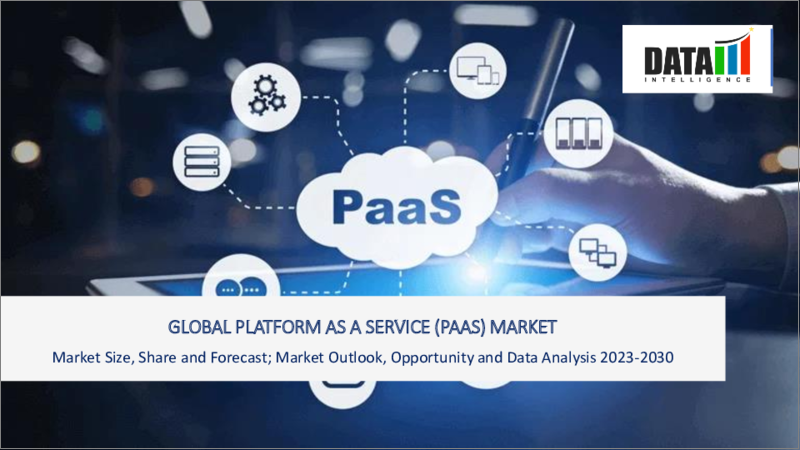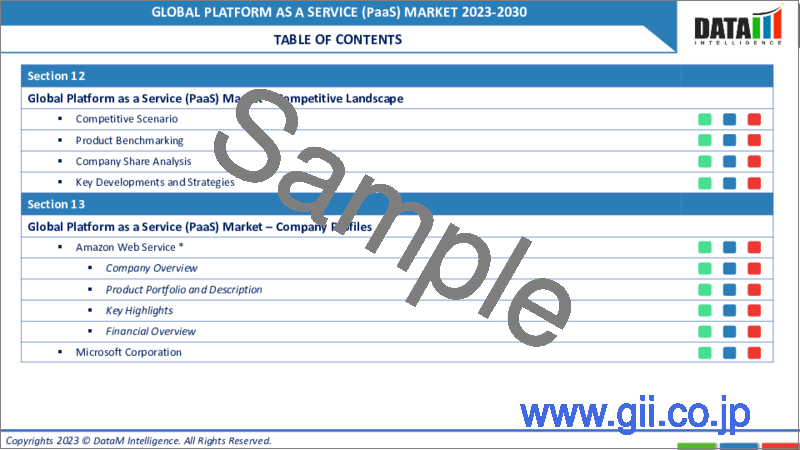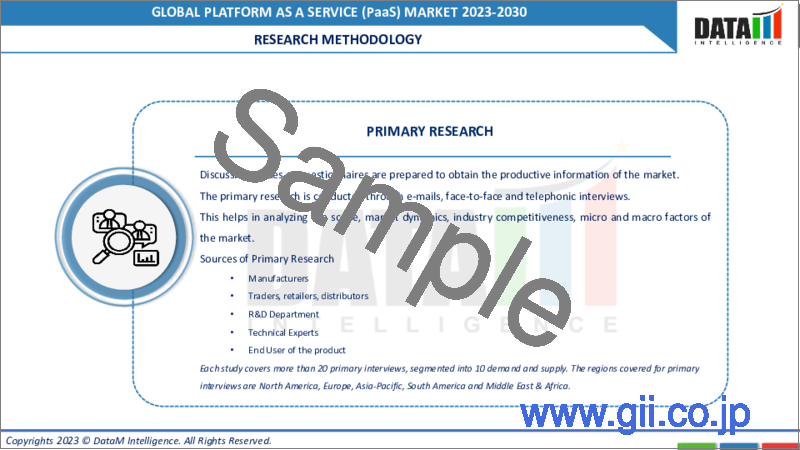|
|
市場調査レポート
商品コード
1208667
PaaS(サービスとしてのプラットフォーム)の世界市場-2022-2029Global Platform as a Service (PaaS) Market - 2022-2029 |
||||||
|
● お客様のご希望に応じて、既存データの加工や未掲載情報(例:国別セグメント)の追加などの対応が可能です。 詳細はお問い合わせください。 |
|||||||
| PaaS(サービスとしてのプラットフォーム)の世界市場-2022-2029 |
|
出版日: 2023年02月01日
発行: DataM Intelligence
ページ情報: 英文 210 Pages
納期: 約2営業日
|
- 全表示
- 概要
- 目次
市場概要
PaaS(Platform as a Service)の世界市場概要
PaaS(サービスとしてのプラットフォーム)の世界市場は、予測期間(2022~2029年)に著しい成長を記録すると予測されます。
PaaS(Platform as a Service)とは、一般的にプログラミング開発で必要とされるインフラを構築・維持することなく、ビジネスアプリケーションを構築・管理・利用できるようにするクラウドコンピューティングサービスです。PaaSは、設計者の生産性を向上させることができるのが大きな特徴です。
PaaS(Platform as a Service)ビジネスは、より早く、より頻繁に価値を提供することで迅速な改善を可能にし、ビジネスのアジリティを即座に支援するものです。PaaSプラットフォームには、複製や強化機能、セキュリティや情報保険機能が頻繁に組み込まれています。社内のセキュリティスキルの必要性を下げながら、セキュリティを高めることができます。
市場力学
組織におけるPaaS利用の増加と、PaaSのさまざまなメリットが、市場上昇の主な要因となっています。また、サービスとしてのプラットフォーム(PaaS)市場の断片化は、将来の成長を制限する可能性があります。
組織におけるPaaSの利用率上昇
PaaS(プラットフォーム・アズ・ア・サービス)モデルのような「as-a-service」技術に投資する企業の増加、5G技術の商用化、クラウドコンピューティングソリューションの利用を支援する政府プログラム、生活水準の向上などが要因として挙げられます。
国家デジタル通信政策2018によると、インド政府は、インドを主要なクラウドコンピューティングのハブとして確立したいと考えています。そのため、同政策では、国際的なデータセンターやコンテンツ配信ネットワークの建設に財政的なインセンティブを提供することを目指しており、今後数年間でPaaS市場の成長を早めることが予想されます。デジタルトランスフォーメーションに取り組む企業は、効率的な作業、迅速なアプリケーションの提供、顧客とのインタラクションの向上などを容易にするPaaSの利用を増やしており、これらはすべて大きなビジネスチャンスを生み出すと予測されます。
PaaSのメリット
PaaSのパラダイムは、リソースの共有、再利用、ライフサイクル管理、自動デプロイメントを可能にし、サービス消費の増加に伴うシステムの拡張に必要なコスト増を最小限に抑えることができます。このような利点から、PaaSはアプリケーションやサービスを作成するための代替手段よりも好まれています。
中小企業や大企業がPaaSソリューションに惹かれるのは、その柔軟性、俊敏性、拡張性、効率性が大きな理由です。また、資本支出(CAPEX)を削減し、運用支出(OPEX)へと支出をシフトすることに重点を置く企業が増えていることも、PaaSソリューションが支持される理由となっています。
高い市場細分化
PaaS(サービスとしてのプラットフォーム)市場の成長は、市場の高い断片化によって妨げられると予想されます。MFT、DBMS、インフォメーション、アプリケーションワーカー、情報融合、BPMイノベーション、B2Bインテグレーションなど、特定のPaaS機能を提供するベンダーが多いため、世界のPlatform as a Service(PaaS)Market Analysisは非常に細分化されています。専門的な企業や顧客がビジネス基盤の大規模アプリケーションを導入し始めると、このレベルの不連続性は極めて非現実的な管理となってしまうのです。
COVID-19影響度分析
PaaS(Platform as a Service)市場分析では、クラウド事業者が提供するツールを使って、顧客がプログラミングアプリケーションを迅速に構築することができます。PASS市場は、プログラミングを強化する企業にとって、安価なサポートコストや機動性の向上など、さまざまなメリットを提供します。近年、データイノベーションの市場を深く支えているのは、分散コンピューティングです。分散コンピューティングの中でも特に重要だと考えられているのが、IaaS(インフラストラクチャー・アズ・ア・サービス)とSAAS(ソフトウェア・アズ・ア・サービス)の2つの部門です。
COVID-19が流行している間、Platform as a Service(PaaS)ビジネスへの関心は洪水に集中していました。しかし、この必要性は、世界的に課されているフル/ハーフロックダウンによるIT消費者支出の減少によって妨げられると予想され、また、世界中の組織に多大な損失をもたらしています。
目次
第1章 PaaS(Platform as a Service)の世界市場の調査手法と範囲
- 調査手法
- 調査目的・調査範囲
第2章 Platform as a Service(PaaS)の世界市場-市場の定義と概要
第3章 Platform as a Service(PaaS)の世界市場- エグゼクティブサマリー
- デプロイメント別市場内訳
- タイプ別市場内訳
- 組織別市場内訳
- エンドユーザー別市場内訳
- 地域別市場内訳
第4章 Platform as a Service(PaaS)世界市場-市場力学
- 市場影響要因
- 促進要因
- 組織におけるPaaSの利用率の上昇
- PaaSのメリット
- 抑制要因
- 高い市場細分化
- ビジネスチャンス
- 影響分析
- 促進要因
第5章 世界のPaaS(Platform as a Service)市場- 産業分析
- ポーターのファイブフォース分析
- サプライチェーン分析
- プライシング分析
- 規制分析
第6章 サービスとしてのプラットフォーム(PaaS)の世界市場-COVID-19分析
- COVID-19の市場に関する分析
- COVID-19登場前の市場シナリオ
- COVID-19の現在の市場シナリオ
- COVID-19以降、または今後のシナリオ
- COVID-19の中での価格ダイナミクス
- 需要-供給スペクトラム
- パンデミック時の市場に関連する政府の取り組み
- メーカーの戦略的な取り組み
- まとめ
第7章 PaaS(サービスとしてのプラットフォーム)の世界市場- デプロイメント別
- パブリック
- プライベート
- ハイブリッド
第8章 PaaS(Platform as a Service)の世界市場:タイプ別
- アプリケーション
- インテグレーション
- データ管理
第9章 サービスとしてのプラットフォーム(PaaS)の世界市場-エンドユーザー別
- BFSI
- ヘルスケア
- 消費財
- 教育
- IT・通信分野
- 政府機関
- その他
第10章 サービスとしてのプラットフォーム(PaaS)の世界市場- 組織別
- 大企業
- 中堅・中小企業
第11章 Platform as a Service(PaaS)の世界市場- 地域別
- 北米
- 米国
- カナダ
- メキシコ
- 欧州
- ドイツ
- 英国
- フランス
- イタリア
- スペイン
- その他欧州
- 南米
- ブラジル
- アルゼンチン
- その他の南米地域
- アジア太平洋地域
- 中国
- インド
- 日本
- オーストラリア
- その他アジア太平洋地域
- 中東・アフリカ地域
第12章 PaaS(Platform as a Service)の世界市場- 競争情勢
- 競合シナリオ
- 市況分析/シェア分析
- M&A(合併・買収)分析
第13章 プラットフォームサービス(PaaS)の世界市場PaaS(サービスとしてのプラットフォーム)の世界市場- 企業プロファイル
- Amazon Web Service
- 企業概要
- 製品ポートフォリオと説明
- 主なハイライト
- 財務概要
- Microsoft Corporation
- Google LLC
- Salesforce.com, Inc.
- Oracle Corporation
- VMware, Inc.
- Rackspace Inc.
- Adobe, Inc.
- Verizon
- SAP SE
第14章 サービスとしてのプラットフォーム(PaaS)の世界市場- 重要な考察
第15章 PaaS(Platform as a Service)の世界市場-DataM
Market Overview
Global Platform as a Service (PaaS) Market Overview
The global platform as a service (PaaS) market reached US$ XX million in 2021 and is expected to record significant growth by reaching up to US$ XX million by 2029, growing at a CAGR of YY% during the forecast period (2022-2029).
Platform as a Service (PaaS) is a cloud computing service that lets users build, manage and use business applications without having to build and maintain the infrastructure that such programming development activities generally require. The ability of a platform as a service (PaaS) to increase a designer's productivity is one of its key benefits.
Platform as a Service (PaaS) Business provides immediate assistance for business agility by enabling quick improvement with quicker and more frequent delivery of value. PaaS platforms frequently incorporate replication and reinforcement features and security and information insurance features. It can increase security while lowering the need for in-house security skills.
Market Dynamics
Rising PaaS usage in organizations and different PaaS benefits are the main factors fueling the market rise. Additionally, the platform as a service (PaaS) market's fragmentation could limit future growth.
The rising usage of PaaS in organizations
The increase in businesses investing in "as-a-service" technologies like the platform-as-a-service (PaaS) model, the commercialization of 5G technology, government programs supporting the use of cloud computing solutions and increases in living standards are all contributing factors.
According to the National Digital Communications Policy 2018, the Indian government wants to establish India as a major cloud computing hub. To that end, the policy aims to offer financial incentives for the construction of international data centers and content delivery networks, which is anticipated to hasten the growth of the PaaS market in the years to come. Businesses undergoing digital transformation increasingly use PaaS because it makes it easier to work efficiently, deliver apps rapidly and improve customer interaction, all of which are projected to create enormous opportunities.
The benefits of PaaS
The PaaS paradigm enables resource sharing, reusing, life-cycle management and automated deployment while minimizing the incremental cost necessary for scaling the system with growth in service consumption. Because of these advantages, PaaS is preferred over alternative options for creating applications and services.
Small, medium-sized and large businesses are drawn to PaaS solutions largely because of their flexibility, agility, scalability and efficiency. PaaS solutions can also support the growing company focus on lowering capital expenditure (CAPEX) and shifting spending to operational expenditure (OPEX).
High market fragmentation
The growth of the global Platform as a service (PaaS) market over the estimated time frame would be hampered by high market fragmentation. Due to many vendors offering specific PaaS functionalities like MFT, DBMSs, informing, application workers, information fusion, BPM innovation and B2B incorporation, the global Platform as a Service (PaaS) Market Analysis is quite fragmented. When specialized businesses and clients begin to implement business-basic large-scale applications, this level of discontinuity is extremely unrealistic to manage.
COVID-19 Impact Analysis
Platform as a Service (PaaS) Market Analysis enables customers to quickly build programming applications using tools provided by the cloud provider. PASS Market offers a variety of advantages to businesses that enhance programming, including cheap support costs and better mobility. The market for data innovation has been profoundly supported recently by distributed computing. The two divisions of distributed computing that are thought to be the most important are infrastructure-as-a-service (IaaS) and software-as-a-service (SAAS).
During the COVID-19 epidemic, interest in Platform as a Service (PaaS) businesses has been focused on the flood. However, this necessity is anticipated to be hampered by the reduction in I.T. consumer spending due to full/half lockdowns imposed globally, which have also resulted in tremendous losses for organizations worldwide.
Segment Analysis
By deployment, the platform as a service (PaaS) market is segmented into public, private and hybrid.
The rising adoption of hybrid cloud services
The platform as a service (PaaS) market is expected to grow fastest during the forecast period, with hybrid deployment expected to lead the pack. It is because major corporations like Amazon, Microsoft and VMware rapidly adopt hybrid cloud solutions to increase productivity and cut costs. Public, private and on-premises clouds are all included in the hybrid cloud.
Companies that offer PaaS use this technology to increase deployment, agility and reduce IT expenses. For instance, in the sector, Amazon Web Service has created a set of hybrid capabilities to profit from the global market.
Geographical Analysis
The rising adoption of cloud services in Asia-Pacific
Asia-Pacific is expected to experience the fastest growth in the platform as a service (PaaS) market in the coming years. Due to the increasing acceptance of cloud services and the growth in the number of small and medium-sized businesses throughout the region, China and India are helping to drive the market's expansion. PaaS is one of the cloud-based services that SMEs heavily utilize to cut down on the expense and complexity of software development.
Additionally, it is anticipated that the market will have plenty of opportunities due to the huge increase in the IT sector. Rising SME spending on cloud infrastructure in China and India during the forecast period contributed to the market's expansion.
Competitive Landscape
The PaaS sector is constantly evolving and changing. Key firms often introduce new techniques to stay competitive in the market. To enhance the customer base, market players are concentrating on increasing investments in the development of cloud services. Additionally, large corporations are pursuing new regions and demographics to boost industry revenue by entering the new market or working with local businesses worldwide.
Major global platform as a service (PaaS) market companies include Amazon Web Service, Microsoft Corporation, Google LLC, Salesforce.com, Inc., Oracle Corporation, VMware, Inc., Rackspace Inc., Adobe, Inc., Verizon and SAP SE.
Salesforce.com, Inc.
Overview: An American provider of cloud-based software, Salesforce, Inc. is situated in San Francisco, California. It offers CRM software and apps focusing on sales, customer service, marketing automation, analytics and application development. It is a business that assists in creating cloud-based software for companies.
Product Portfolio: The business offers PaaS services. Software as a Service (SaaS), Infrastructure as a Service (IaaS) and Everything as a Service are other members of the PaaS family of cloud computing products (XaaS). With the help of the cloud computing paradigm, businesses may outsource their computer needs and focus more of their resources on their core competencies.
Key Development: Salesforce.com, Inc. and Microsoft Corporation collaborated in November 2019 to support clients in meeting evolving business requirements.
Why Purchase the Report?
- Visualize the composition of the platform as a service (PaaS) market segmentation by deployment, type, organization, end-user and region, highlighting the critical commercial assets and players.
- Identify commercial opportunities in the platform as a service (PaaS) market by analyzing trends and co-development deals.
- Excel data sheet with thousands of platform as a service (PaaS) market-level 4/5 segmentation points.
- Pdf report with the most relevant analysis cogently put together after exhaustive qualitative interviews and in-depth market study.
- Product mapping in excel for the key product of all major market players
The global platform as a service (PaaS) market report would provide access to an approx. 69 market data table, 65 figures and 210 pages.
Target Audience 2022
- Platform as a Service (PaaS) Providers/ Buyers
- Industry Investors/Investment Bankers
- Education & Research Institutes
- Emerging Companies
- Platform as a Service (PaaS) Manufacturers
Table of Contents
1. Global Platform as a Service (PaaS) Market Methodology and Scope
- 1.1. Research Methodology
- 1.2. Research Objective and Scope of the Report
2. Global Platform as a Service (PaaS) Market - Market Definition and Overview
3. Global Platform as a Service (PaaS) Market - Executive Summary
- 3.1. Market Snippet By Deployment
- 3.2. Market Snippet By Type
- 3.3. Market Snippet By Organization
- 3.4. Market Snippet By End-User
- 3.5. Market Snippet By Region
4. Global Platform as a Service (PaaS) Market-Market Dynamics
- 4.1. Market Impacting Factors
- 4.1.1. Drivers
- 4.1.1.1. The rising usage of PaaS in organizations
- 4.1.1.2. The benefits of PaaS
- 4.1.2. Restraints
- 4.1.2.1. High market fragmentation
- 4.1.2.2. XX
- 4.1.3. Opportunity
- 4.1.3.1. XX
- 4.1.4. Impact Analysis
- 4.1.1. Drivers
5. Global Platform as a Service (PaaS) Market - Industry Analysis
- 5.1. Porter's Five Forces Analysis
- 5.2. Supply Chain Analysis
- 5.3. Pricing Analysis
- 5.4. Regulatory Analysis
6. Global Platform as a Service (PaaS) Market - COVID-19 Analysis
- 6.1. Analysis of COVID-19 on the Market
- 6.1.1. Before COVID-19 Market Scenario
- 6.1.2. Present COVID-19 Market Scenario
- 6.1.3. After COVID-19 or Future Scenario
- 6.2. Pricing Dynamics Amid COVID-19
- 6.3. Demand-Supply Spectrum
- 6.4. Government Initiatives Related to the Market During Pandemic
- 6.5. Manufacturers Strategic Initiatives
- 6.6. Conclusion
7. Global Platform as a Service (PaaS) Market - By Deployment
- 7.1. Introduction
- 7.1.1. Market Size Analysis and Y-o-Y Growth Analysis (%), By Deployment
- 7.1.2. Market Attractiveness Index, By Deployment
- 7.2. Public*
- 7.2.1. Introduction
- 7.2.2. Market Size Analysis and Y-o-Y Growth Analysis (%)
- 7.3. Private
- 7.4. Hybrid
8. Global Platform as a Service (PaaS) Market - By Type
- 8.1. Introduction
- 8.1.1. Market Size Analysis and Y-o-Y Growth Analysis (%), By Type
- 8.1.2. Market Attractiveness Index, By Type
- 8.2. Application*
- 8.2.1. Introduction
- 8.2.2. Market Size Analysis and Y-o-Y Growth Analysis (%)
- 8.3. Integration
- 8.4. Data Management
9. Global Platform as a Service (PaaS) Market - By End-User
- 9.1. Introduction
- 9.1.1. Market Size Analysis and Y-o-Y Growth Analysis (%), By End-User
- 9.1.2. Market Attractiveness Index, By End-User
- 9.2. BFSI*
- 9.2.1. Introduction
- 9.2.2. Market Size Analysis and Y-o-Y Growth Analysis (%)
- 9.3. Healthcare
- 9.4. Consumer Goods
- 9.5. Education
- 9.6. IT and Telecommunication
- 9.7. Government
- 9.8. Others
10. Global Platform as a Service (PaaS) Market - By Organization
- 10.1. Introduction
- 10.1.1. Market Size Analysis and Y-o-Y Growth Analysis (%), By Organization
- 10.1.2. Market Attractiveness Index, By Organization
- 10.2. Large Enterprises*
- 10.2.1. Introduction
- 10.2.2. Market Size Analysis and Y-o-Y Growth Analysis (%)
- 10.3. Small and Medium Enterprises
11. Global Platform as a Service (PaaS) Market - By Region
- 11.1. Introduction
- 11.2. Market Size Analysis and Y-o-Y Growth Analysis (%), By Region
- 11.3. Market Attractiveness Index, By Region
- 11.4. North America
- 11.4.1. Introduction
- 11.4.2. Key Region-Specific Dynamics
- 11.4.3. Market Size Analysis and Y-o-Y Growth Analysis (%), By Deployment
- 11.4.4. Market Size Analysis and Y-o-Y Growth Analysis (%), By Type
- 11.4.5. Market Size Analysis and Y-o-Y Growth Analysis (%), By Organization
- 11.4.6. Market Size Analysis and Y-o-Y Growth Analysis (%), By End-User
- 11.4.7. Market Size Analysis and Y-o-Y Growth Analysis (%), By Country
- 11.4.7.1. U.S.
- 11.4.7.2. Canada
- 11.4.7.3. Mexico
- 11.5. Europe
- 11.5.1. Introduction
- 11.5.2. Key Region-Specific Dynamics
- 11.5.3. Market Size Analysis and Y-o-Y Growth Analysis (%), By Deployment
- 11.5.4. Market Size Analysis and Y-o-Y Growth Analysis (%), By Type
- 11.5.5. Market Size Analysis and Y-o-Y Growth Analysis (%), By Organization
- 11.5.6. Market Size Analysis and Y-o-Y Growth Analysis (%), By End-User
- 11.5.7. Market Size Analysis and Y-o-Y Growth Analysis (%), By Country
- 11.5.7.1. Germany
- 11.5.7.2. UK
- 11.5.7.3. France
- 11.5.7.4. Italy
- 11.5.7.5. Spain
- 11.5.7.6. Rest of Europe
- 11.6. South America
- 11.6.1. Introduction
- 11.6.2. Key Region-Specific Dynamics
- 11.6.3. Market Size Analysis and Y-o-Y Growth Analysis (%), By Deployment
- 11.6.4. Market Size Analysis and Y-o-Y Growth Analysis (%), By Type
- 11.6.5. Market Size Analysis and Y-o-Y Growth Analysis (%), By Organization
- 11.6.6. Market Size Analysis and Y-o-Y Growth Analysis (%), By End-User
- 11.6.7. Market Size Analysis and Y-o-Y Growth Analysis (%), By Country
- 11.6.7.1. Brazil
- 11.6.7.2. Argentina
- 11.6.7.3. Rest of South America
- 11.7. Asia-Pacific
- 11.7.1. Introduction
- 11.7.2. Key Region-Specific Dynamics
- 11.7.3. Market Size Analysis and Y-o-Y Growth Analysis (%), By Deployment
- 11.7.4. Market Size Analysis and Y-o-Y Growth Analysis (%), By Type
- 11.7.5. Market Size Analysis and Y-o-Y Growth Analysis (%), By Organization
- 11.7.6. Market Size Analysis and Y-o-Y Growth Analysis (%), By End-User
- 11.7.7. Market Size Analysis and Y-o-Y Growth Analysis (%), By Country
- 11.7.7.1. China
- 11.7.7.2. India
- 11.7.7.3. Japan
- 11.7.7.4. Australia
- 11.7.7.5. Rest of Asia-Pacific
- 11.8. Middle East and Africa
- 11.8.1. Introduction
- 11.8.2. Key Region-Specific Dynamics
- 11.8.3. Market Size Analysis and Y-o-Y Growth Analysis (%), By Deployment
- 11.8.4. Market Size Analysis and Y-o-Y Growth Analysis (%), By Type
- 11.8.5. Market Size Analysis and Y-o-Y Growth Analysis (%), By Organization
- 11.8.6. Market Size Analysis and Y-o-Y Growth Analysis (%), By End-User
12. Global Platform as a Service (PaaS) Market - Competitive Landscape
- 12.1. Competitive Scenario
- 12.2. Market Positioning/Share Analysis
- 12.3. Mergers and Acquisitions Analysis
13. Global Platform as a Service (PaaS) Market - Company Profiles
- 13.1. Amazon Web Service
- 13.1.1. Company Overview
- 13.1.2. Product Portfolio and Description
- 13.1.3. Key Highlights
- 13.1.4. Financial Overview
- 13.2. Microsoft Corporation
- 13.3. Google LLC
- 13.4. Salesforce.com, Inc.
- 13.5. Oracle Corporation
- 13.6. VMware, Inc.
- 13.7. Rackspace Inc.
- 13.8. Adobe, Inc.
- 13.9. Verizon
- 13.10. SAP SE
LIST NOT EXHAUSTIVE
14. Global Platform as a Service (PaaS) Market - Premium Insights
15. Global Platform as a Service (PaaS) Market - DataM
- 15.1. Appendix
- 15.2. About Us and Private
- 15.3. Contact Us




